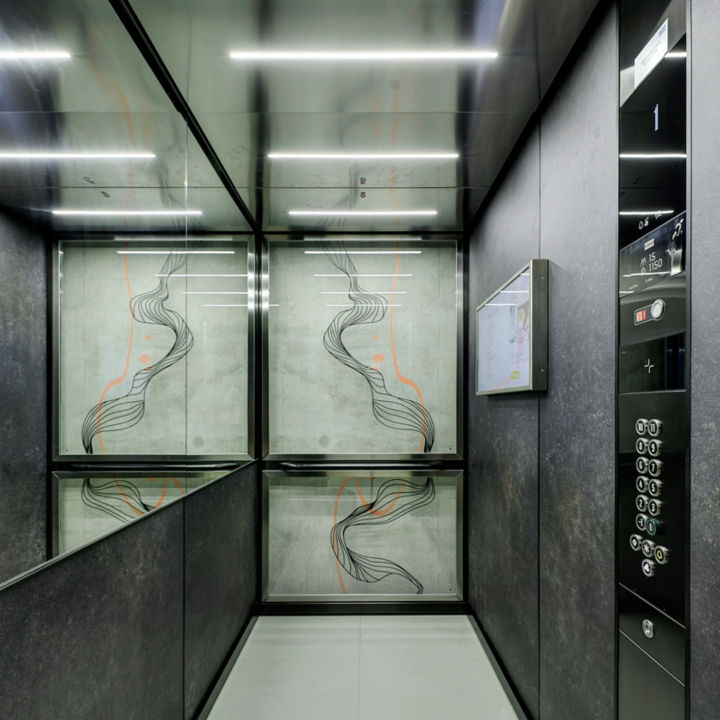
As everyone knows, adjusting a thermostat can be a touchy subject in many households. You want to stay comfortable, but you don’t want to waste money. Now scale this challenge up to commercial buildings and indoor climate becomes a major issue. In Tallinn, Estonia, the partners KONE, Mainor Ülemiste and R8 Technologies came up with a clever idea: data from elevators could be used to optimize heating and cooling systems to improve comfort and sustainability at the business campus.
The starting point was this: KONE’s equipment and KONE 24/7 Connect already collect data to make elevators run more efficiently. For example, elevators gather information for predictive maintenance and on how people move around the building at different times of the day. This allows cars to be positioned proactively to minimize wait times and wasted trips.
“We had worked with KONE previously, using data to optimize people flow, but we wondered what else could be done with the elevator data. Could it be used to improve energy efficiency in other ways?” says Rene Klesment, CTO of Mainor Ülemiste.
Test City as a real-life testbed for future technologies
Mainor Ülemiste is the developer of the largest business center in the Baltics, Ülemiste City. The company brings together eager innovators, and they even have a special Test City to trial smart solutions in real-world environments. The partners decided to use an eight-year-old building with thirteen floors and six elevators to test the idea.
HVAC systems consume up to 70% of a building’s energy, making their energy efficiency key to reducing emissions.
The plan was to develop specific algorithms and use elevator sensor data as proxies for occupancy. If everyone went to the fifth floor for a meeting, for example, the HVAC systems could adjust temperatures on each floor accordingly.
“Our goal was to increase energy efficiency while maintaining tenant comfort,” Klesment says. “It was a good project for us, matchmaking with companies to build smarter, data-based buildings.”
AI solution integrates with elevator data

The partners developed data-driven innovative solutions to enhance the performance of the HVAC systems at Ülemiste City.
“We are using general user behavior forecasts while ensuring the management of significant deviations,” says Siim Täkker, CEO of R8 Technologies. “The system can learn that 90% of people typically leave the office by 5 pm on Friday, for instance, but what about holidays when no one comes to work? Or maybe one floor has a big office holiday party at night. We also need to manage these unusual events automatically.”
R8 Technologies is a growing tech company that has developed R8 Jenny, a human centric AI solution to optimize HVAC systems. R8 Jenny communicates with building automation systems, proactively optimizing heating, cooling and ventilation systems to provide desired indoor climate with the lowest energy cost.
“Our software integrates with building's other digital systems, so we gladly cooperated with KONE to use elevators as a data source. KONE provided exactly what we needed,” Täkker continues. “We didn’t have to add new sensors or cameras because we could leverage elevators as an information source. It was a great way to maximize the use of existing infrastructure.”
Creating the ideal indoor climate

The results of the test trial were impressive. The partners were able to lower energy use and emissions by up to 36% compared to a non-optimized building. The test building could save up to €50,000 and reduce CO2 emissions by 140 tons annually. Täkker believes it is entirely realistic to see significant savings also in buildings that have been previously optimized by other building management systems.
“This is a great example of what can be achieved with collaborations,” says Tero Hottinen, vice president, head of strategic partnerships at KONE. “We were able to take our elevator data ‘out of the shaft’ so to speak, combine it with advanced algorithms, and use these as a KONE secret sauce to optimize HVAC systems.”
He is already looking forward to finding other innovative ways to use KONE elevator data and insights.
“In the future, we can find new uses for this data, such as planning maintenance or janitorial activities to reduce nuisances to the people using the buildings. KONE is already involved in a project where restaurants use predictive analytics to more accurately estimate the dining flow and number of diners and reduce food waste. There are many opportunities to apply elevator data to broader sustainability topics and better user experience.”
The experiment at Ülemiste City also led to better experience for the people using the building.
“As every property manager knows, if a tenant is unhappy, they will tell you. If someone is too hot or too cold, they will let you know about it,” Klesment says. “We never received a single complaint. They never noticed a thing!”
Happy users make happy property owners. This triple partnership proved that smart solutions based on elevator data can be used to optimize not just the elevator use and maintenance but also HVAC systems in the building. This in turn leads to lower expenses and emissions – a win-win for everyone.
